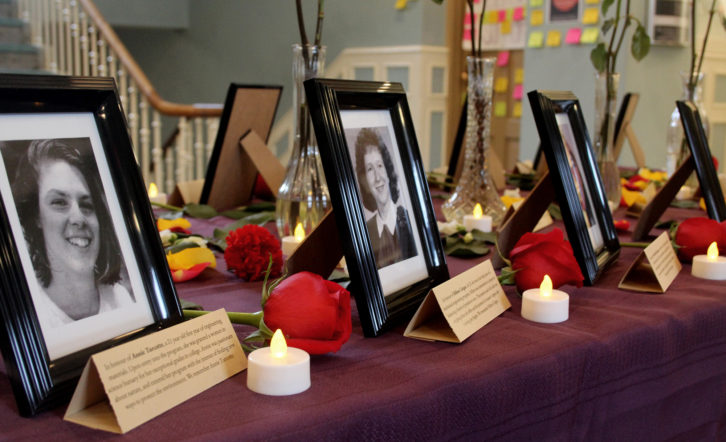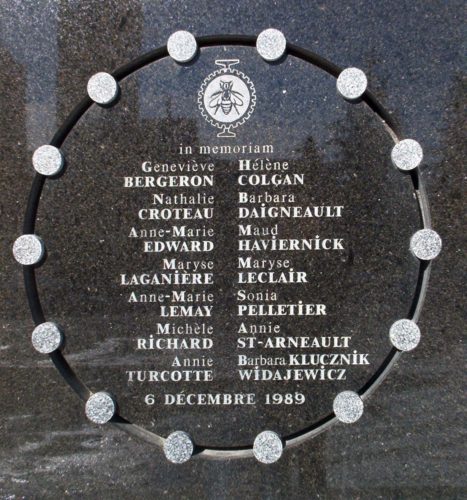Shining a spotlight on the victims of the Montreal massacre
This year marks the 30th anniversary of the École Polytechnique massacre

caption
Anne-Marie Lemay was one of 14 women who lost their lives on Dec. 6, 1989. Her picture is displayed at the University of King's College's vigil.Dalhousie University is one of 14 schools that will shine a spotlight into the sky to commemorate the Montreal École Polytechnique massacre.
Across Canada, engineering students are participating in a national vigil to remember the victims of the shooting.
The tradition began in Montreal. Every year, the city shines 14 spotlights into the sky as the name of each victim is announced.
“It is nice to see these commemorative events everywhere,” said Laurent Chartier, who was personally touched by the massacre. Related stories
This year, the ceremony will consist of shining single spotlights all at the same time, promoting a sense of support and unity.
It marks the 30th anniversary of the massacre. Attendees will wear white ribbons, an international symbol for the National Day of Remembrance and Action on Violence Against Women.

caption
The University of King’s College commemorates the victims of the École Polytechnique massacre.Remembering those lost
Chartier was in his fourth year studying mechanical engineering at École Polytechnique when 14 of his peers were killed by an armed man on Dec. 6, 1989.
Among the victims was his girlfriend at the time, Anne-Marie Lemay.
At around 5:10 p.m. that day, a gunman entered the engineering school with the intent to kill women for studying in scientific fields. Twenty minutes later, he had killed 14 women and injured 10 women and four men before taking his own life. The event left Montreal in a state of shock.
In the days that followed the massacre, Chartier said he did not take the time to process the event. He was back at school a few days later, finishing his final project.
“For a lot of people who lose somebody, it’s hard to stay at home and do nothing,” said Chartier. “Working on something I liked took my mind off of the event.”
With this came a lot of guilt. Chartier admits that thinking back on his reaction led him to ask himself many questions.
“What could I have done?” he said.
The event had a rippling effect throughout the country. Years later, Chartier’s wife told him she felt a hush fall over the otherwise-bustling city in the days following the attack.
“Nobody was speaking,” he said. “The atmosphere was very strange and quiet.”
This was true of Chartier’s experience, who only talked to his best friend about the massacre on his 40th birthday. In 1989, they carpooled and worked on their final projects together, but never talked about what happened.
“I don’t have any regrets, but it’s strange that we didn’t talk about it at that time,” he said.
Chartier believes people’s sensitivity to his personal relationship with Lemay led to years of avoiding the conversation. He said people often comment that memorials must be difficult for victims’ loved ones.
But for him, he’s happy Canada keeps remembering.
This is a sentiment shared by Sara Evely, the organizer of Dalhousie’s vigil and the president of the Dalhousie Women in Engineering Society.
“Unfortunately, I think that this event and the commemoration every year does do that. It highlights the fact that women haven’t always belonged in STEM,” said Evely.

caption
The names of the victims are immortalized on a plaque at the University of Montreal.Women in engineering
Evely is a civil engineering student. She said for her, the event is important because it draws attention to the issues that women still face today, particularly in STEM fields — science, technology, engineering and mathematics.
“It’s good because it educates us all about how far we’ve come and gives respect to those who have bravely broken those boundaries before us,” she said.
Evely said she had never heard of the massacre until she came to Dalhousie. She learned about the massacre’s history after joining the Dalhousie Women in Engineering Society as a volunteer.
“I just couldn’t believe that that had actually occurred,” she said. “And that I had never heard about it.”
This year, the Dalhousie Women in Engineering Society has changed the event’s name to Remembrance and Resilience ceremony, because for Evely, it is about more than just remembering the victims. It has also become symbolic for resilience and encouraging women to pursue their passions, no matter their field of interest.
“It’s a problem today, it’s going to be a problem tomorrow, and we need to have strong leaders who can advocate firmly for the women,” she said.
In 2011, Engineers Canada launched the 30 by 30 initiative. The goal is to have a national average of 30 per cent representation of women in engineering by the year 2030. The national average currently sits at 18.1 per cent.
Chartier agrees there should be more women in STEM fields.
“It’s a good thing to have more women in engineering,” he said. “I hope it didn’t frighten anybody to go to Polytechnique or to an engineering career.”
The commemoration at Dalhousie University will take place in the Irving Oil Auditorium. A presentation will be held introducing the victims and will be followed with the in-memoriam spotlight from 5:30 p.m. to 6:15 p.m.
The spotlights will carry the names of:
- Geneviève Bergeron, 21, civil engineering
- Hélène Colgan, 23, mechanical engineering
- Nathalie Croteau, 23, mechanical engineering
- Barbara Daigneault, 22, mechanical engineering
- Anne-Marie Edward, 21, chemical engineering
- Maud Haviernick, 29, materials engineering
- Maryse Laganière, 23, budget clerk for the finance department
- Maryse Leclair, 23, materials engineering
- Anne-Marie Lemay, 21, mechanical engineering
- Sonia Pelletier, 28, mechanical engineering
- Michèle Richard, 21, materials engineering
- Annie St-Arneault, 23, mechanical engineering
- Annie Turcotte, 20, materials engineering
- Barbara Klucznik-Widajewicz, 31, nursing student
About the author
Marianne Lassonde
Marianne is a journalism student at the University of King's College. She calls Sherbrooke, Quebec, home. When she is not reporting, she is either...
Chelsea Cleroux
Chelsea is a student journalist at the University of King's College in Halifax. She has a degree in Political Science from the University of...

L
Lucie Lassonde
G
Georges Belisle
K
Katjia
L
Laurent Chartier